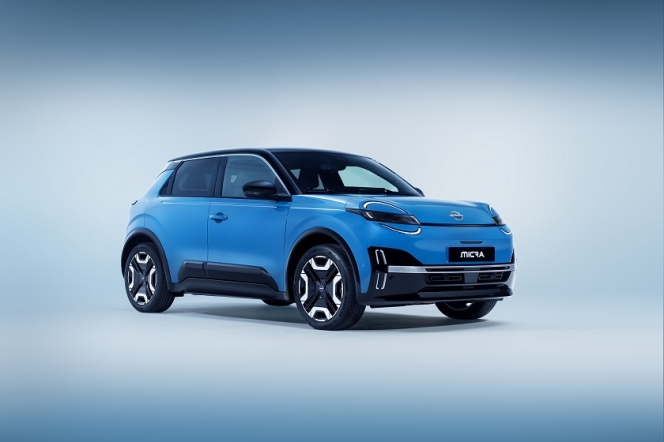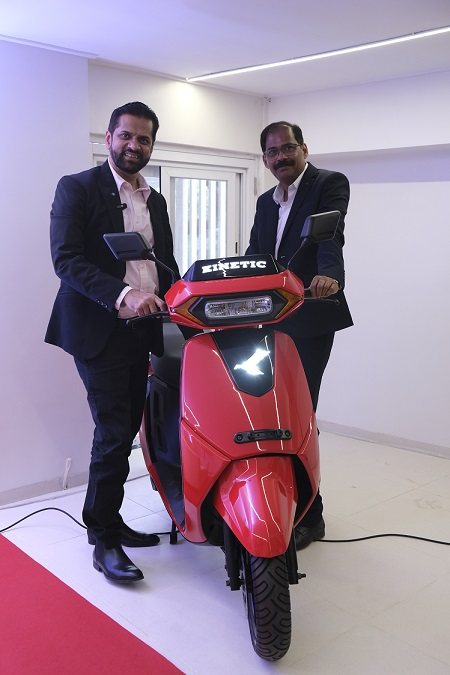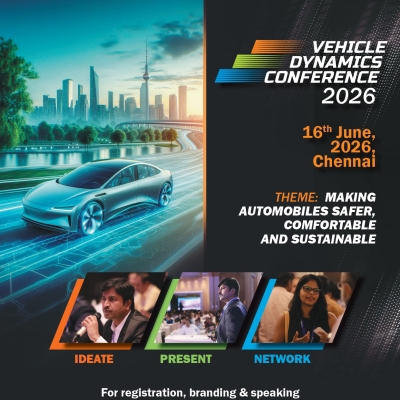Nissan Unveils All-New Electric Micra
- By MT Bureau
- May 22, 2025

Japanese automaker Nissan has officially revealed the sixth-generation Micra, a fully electric, connected city car set to return to the B-segment in 2025. Designed at Nissan Design Europe in London, the Micra sports a fresh SUV-inspired look and will be the first of four new EVs Nissan plans to launch in Europe by 2027, alongside the new Leaf, Juke and an A-segment model.
Powered by a choice of two battery options – 40kWh and 52kWh – the Micra delivers up to 408km of claimed range. It features fast-charging capability, with a 100kW DC charger (80kW for the 40kWh variant) offering a 15-80 percent top-up in just 30 minutes. Vehicle-to-Load (V2L) technology allows the car to power external devices, from air pumps to camping gear.
Giovanny Arroba, Vice-President - Nissan Design Europe, said, “In designing the sixth generation of the all-new Micra, we’ve celebrated all of the values that have historically made it so popular – and opened a new chapter for Micra as an EV. The exterior has an audacious and playful appearance on first look, but has a stance which gives it a solid presence on the road. We’ve also been able to integrate delightful details into the design, which owners will love. We’re proud to have been able to bring the Micra into the EV age.”
Built on the AmpR EV platform, the MICRA weighs as little as 1,400kg and features a low-mounted battery pack and multi-link rear suspension – promising agile handling and class-leading ride comfort. A range of drive modes (Comfort, Sport, Eco and Perso) allows drivers to tailor performance and ambiance.
Inside, the Micra offers a minimalist yet premium interior with dual 10.1-inch displays, customisable ambient lighting and three upholstery trim choices: Modern, Audacious and Chill. A hidden Mount Fuji silhouette and tactile three-spoke steering wheel add thoughtful design flair.
Cliodhna Lyons, Region Vice-President, Product and Services Planning, Nissan AMIEO (Africa, Middle East, India, Europe & Oceania), said, “The all-new Micra combines irresistible and playful design, with intuitive tech and an EV powertrain which delivers both excellent range and fast-charging capability for an easy and enjoyable ownership experience. I’m confident that the all-new Micra will please both the head and the heart of buyers who are looking for an agile EV for their daily lives and longer trips.”
Connectivity is central to the new MICRA experience. Google built-in offers access to Maps, Assistant and Google Play, while in-car route planning considers real-time energy use and charging availability. Apple CarPlay and Android Auto are also standard.
On the safety front, the Micra is equipped with Nissan’s ProPilot Assist, Autonomous Emergency Braking, Blind Spot Intervention, Rear Cross Traffic Alert and more, ensuring a high standard of driver assistance technology.
| NISSAN MICRA | ||
| Battery capacity* | 40kWh* | 52kWh* |
| Max power | 90kW | 110kW |
| Max torque | 225Nm | 245Nm |
| Range | 310km | 408km |
| Weight | 1400kg | 1524kg |
| *All figures subject to homologation | ||
Blue Energy Launches Battery Swapping EV Truck, Plots INR 35 Billion Facility In Maharashtra
- By MT Bureau
- October 16, 2025

Pune-headquartered alternative energy vehicle manufacturer Blue Energy Motors (BEM) has launched its electric heavy-duty truck, which is equipped with battery swapping technology.
The truck was unveiled by the Chief Minister of Maharashtra, Devendra Fadnavis, at Blue Energy Motors’ Chakan facility in Pune. Fadnavis also inaugurated, what is claimed to be India’s first electric corridor from Mumbai–Pune, which is the first step in a plan to electrify national highway corridors over the next three years.
What’s more, Blue Energy Motors has signed an MoU with the Maharashtra government to set up a new facility with a capacity of 30,000 trucks, backed by an investment of INR 35 billion. The automaker has received strong demand for its e-trucks and has signed MoUs for over 10,000 units.
The new e-truck is designed for Indian conditions and follows the success of Blue Energy Motors’ LNG-powered fleet. It features an unlimited range with battery swapping, the highest payload in its category and Advanced Mobility Intelligence. The launch also introduces India’s first Energy-as-a-Service model for heavy-duty trucks.
Devendra Fadnavis, said, “This launch showcases Maharashtra’s leadership in sustainable innovation. Blue Energy Motors’ Made-in-India Electric Truck with Battery Swapping Technology, along with the Mumbai–Pune corridor, India’s first highway to go electric aligns seamlessly with the nation’s vision for Atmanirbhar Bharat and for a greener, self-reliant future. I applaud their efforts in advancing both environmental sustainability and industrial growth”.
Anirudh Bhuwalka, Founder and Managing Director, Blue Energy Motors, said, “We believe that this is the beginning of the EV Revolution in India for heavy-duty trucks. Our electric truck delivers unlimited range through battery swapping, highest payload in its category and Advanced Mobility Intelligence for fleet reliability. The Mumbai–Pune corridor is the first step in building a nationwide network of sustainable logistics, driving India’s green freight future forward. With our Energy-as-a-Service model, we’re redefining fleet economics offering reduced upfront capital cost, lowest TCO with highest payload, minimal charging downtime and making it well-to-wheel green with renewable energy.”
Also read: Montra Electric Launches 55-Tonne Rhino E-Truck, Unveils Battery Swap Technology Too
- Simple Energy
- Simple One Gen 1.5
- Simple OneS
- Amazon India
- Flipkart
- Amazon India’s Great Indian Festival
- Flipkart’s Big Bang Diwali Sale
- Suhas Rajkumar
Simple Energy Partners Amazon India And Flipkart To Sell E-Scooters Online
- By MT Bureau
- October 16, 2025

Bengaluru-based electric vehicle manufacturer Simple Energy has partnered with Amazon India and Flipkart to make its electric scooters available online.
The collaboration will allow customers to browse, book and receive doorstep delivery of its electric scooters, the Simple One Gen 1.5 and Simple OneS. The move is intended to simplify the buying journey and expand the company’s reach into Tier 2 and Tier 3 cities.
Furthermore, Simple Energy is also offering discounts on both models as part of Amazon India’s Great Indian Festival and Flipkart’s Big Bang Diwali sale.
Customers can avail up to INR 16,434 off through various bank and card offers, including discounts on HDFC Bank and Amazon Pay ICICI Bank Cards on Amazon India’s Great Indian Festival.
While Flipkart customers can get a flat discount of INR 7,500 on the Simple One and INR 5,000 on the Simple OneS, with potential additional savings using SBI and Flipkart Axis Bank cards. A 12-month no-cost EMI option is also available.
Suhas Rajkumar, Founder & CEO, Simple Energy, said, “Diwali symbolises progress and new beginnings, making it the perfect moment to advance our mission of democratising electric mobility. Through our partnership with Amazon India and Flipkart, we are expanding our reach across India, including Tier 2 and Tier 3 cities and offering a seamless, tech-first purchase experience that makes EV ownership simpler and more accessible than ever.”
At present, Simple Energy operates 57 showrooms across India and plans to expand its retail operations to include 150 new stores and 200 service centres across the country by FY 2026.
- Kinetic Watts & Volts
- Kinetic Group
- Ajinkya Firodia
- Ravindra Sharad Bhelke
- Kinetic DX
- Range-X
- Kinetic DX+
- Kinetic ZX
Kinetic Watts & Volts Opens First Exclusive EV Dealership In Pune
- By MT Bureau
- October 16, 2025
Kinetic Watts & Volts, the electric vehicle division of the Kinetic Group, has opened its first exclusive 3S dealership in Pune, India.
The new facility is spread across 1,400 sqft, is located at Tingre Nagar, Pune and is owned and operated by Ravindra Sharad Bhelke. Additionally, a dedicated 1,050 sqft service facility, ‘Kinetic Lab,’ has been set up nearby in Dhanori to ensure aftersales support.
Ajinkya Firodia, Vice-Chairman & Managing Director, Kinetic Watts & Volts, said, “This is a proud and defining moment for Kinetic as we inaugurate our first exclusive EV showroom in India. Pune has always been special to us, it’s where our legacy began and now, where our EV journey takes shape. This launch represents not just a retail milestone, but the beginning of a new chapter in accessible, aspirational, and sustainable electric mobility for India.”
 The new Kinetic EV range reimagines the iconic Kinetic DX as a family-friendly electric scooter. The line-up includes two variants: Kinetic DX and Kinetic ZX (formerly DX+).
The new Kinetic EV range reimagines the iconic Kinetic DX as a family-friendly electric scooter. The line-up includes two variants: Kinetic DX and Kinetic ZX (formerly DX+).
Both models are powered by a 2.6 kWh Range-X LFP battery, which the company states offers up to four times longer life than NMC-based scooters.
The Kinetic DX is priced at INR 111,499 (ex-showroom, Pune) and Kinetic ZX (formerly DX+) is priced at INR 117,499 (ex-showroom, Pune).
Key features of the scooters include K-Coast regenerative braking, reverse assist and hill-hold assist, along with three ride modes: Range, Power, and Turbo. The ZX variant adds smart connectivity via the Telekinetic app, which provides real-time ride data, geo-fencing and intruder alerts. It also includes My Kiney Voice Alerts and a Kinetic Assist switch for CRM connection.
Ravindra Bhelke, Dealer Principal, Kinetic EV Vishrantwadi, said, “Becoming the first Kinetic EV dealer in India is both an honour and a responsibility. I have grown up seeing the trust people have in the Kinetic name, and now I am proud to bring its electric future to Pune. With this showroom and our dedicated service centre, our goal is to give every customer a premium, transparent and reliable experience, whether they are buying their first EV or upgrading from a traditional scooter.”
Oben Electric To Open 10 New Showrooms And Service Centres In Gujarat
- By MT Bureau
- October 16, 2025

Oben Electric, an Indian electric motorcycle manufacturer, has announced plans to expand its presence in Gujarat with 10 new showrooms and service centres set to open in 2026. The expansion will cover Ahmedabad and other cities including Vadodara, Surat, Rajkot and Jamnagar.
At present, the company operates a showroom and an Oben Care service centre in Memnagar, Ahmedabad. The expansion follows the response to the company’s city commuter model, the Rorr EZ Sigma.
Sagar Thakkar, Co-Founder & CPO, Oben Electric, said, "The positive response we have received for Rorr EZ Sigma reinforces our belief that urban commuting is evolving towards electric motorcycles designed to meet the needs of daily commuters. Rorr EZ Sigma delivers effortless performance and the right balance of power, practicality, and connectivity for everyday riding. The encouraging response from customers in Gujarat has further strengthened our commitment to expand across key cities like Vadodara, Surat, Rajkot and Jamnagar, as we work towards making EV motorcycles more accessible for riders across the country.”
The Rorr EZ Sigma priced from INR 129,000, is available in 3.4 kWh and 4.4 kWh variants. Key features include – up to 175km range, top speed of 95 kmph, three ride modes – Eco, City, and Havoc. It uses the company’s patented LFP battery that is claimed to provide 50 percent higher heat resistance and a 2x lifecycle. It also gets features like reverse mode and a 5-inch TFT display with navigation and smart alerts.
At present, Oben Electric has over 50 showrooms nationwide and aims to reach 150 showrooms and service centres by the end of the fiscal year.






Comments (0)
ADD COMMENT